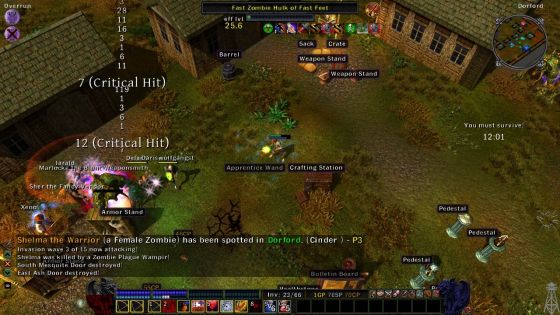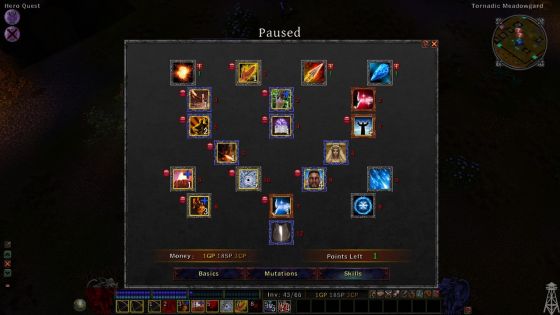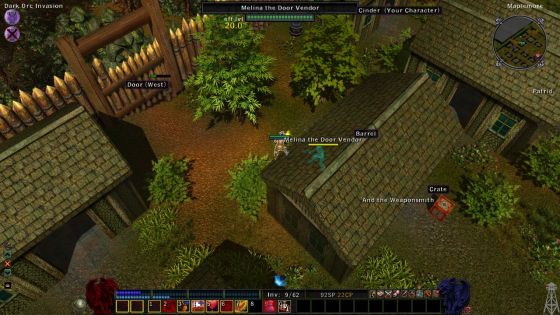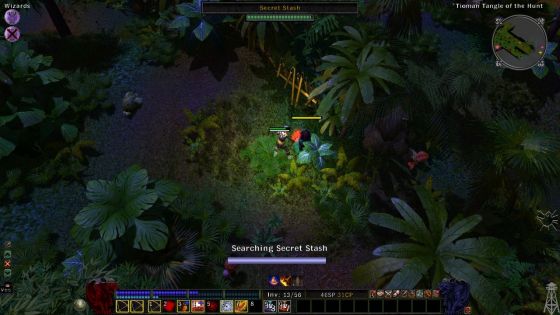Din's Legacy Review

On the surface, Din's Legacy appears to be a very similar game to the original Diablo or Fate hack and slay games. In both of those games you travel with a single character through a dungeon with random floor layouts, encounter a variety of random creatures, find all manner of random loot and deal with the occasional trap or other surprise. However, Din's Legacy has a few things which sets it apart from other ARPGs. First, you're playing through a sequence of short scenarios, most of which feature your hero in charge of defending and saving a town and second the game features dynamic monster factions which are not only trying to destroy your town (or other towns), but also fighting amongst themselves. Also, in Din's Legacy, you play a mutant and the game introduces a mutation system, which lets you multiclass your character to a certain degree and gives your character random advantages and disadvantages over the course of the game. Din's Legacy is in many ways different from genre leaders like Diablo 3, Torchlight 2, Grim Dawn or Path of Exile and those differences are great enough that they may interest or turn off fans of those games.
Story and Atmosphere
Hack and slay ARPGs like Diablo are usually thin on story, if there is a story at all. While that may be the case, they are usually thick on atmosphere, whether it's the colorful antique era countryside of a Titan Quest or the apocalyptic darkness of a Diablo and Grim Dawn or the horror steam punk world of a Van Helsing.
Din's Legacy's story is summed up in a text window during the first few seconds of the game. You are a member of the race of mutants, a young race created by the god Din. And you want to prove that your race belongs among the forces of order and good, like the elves and humans, and not among the forces of destruction and evil, like many monsters and orcs do. For that reason, you are going out of your way to aid settlements besieged by evil and destruction. And that's pretty much it for the story.
That's it for the game's story.
While Din's Legacy has a lot of weird and unique monsters, like the dog like Ragnars or the imp like Little Sisters, it doesn't have an atmosphere which is memorable. The world is colorful, but the monsters aren't visually memorable. Most boss monsters are simply bigger variants of the smaller cousins, and there is little to make the game's places, towns, or architecture memorable. This is not only true when it comes to the game's graphics, but there is also the absence of any sort of lore. Perhaps the one exception are the game's regions which are usually named after a mechanical quality they have. You can be sure that the Spider Wastes is full of monstrous spiders, or the Marsh of Poison Mists is covered by poison mist. Occasionally boss monsters will send you a message, but this is usually some sort of random taunt.
The taunt windows attempt to give some character to your procedurally generated opponents. I've left Craig alive too long and now he's created another problem I have to solve before winning the scenario.
This means that much of Din's Legacy's story and atmosphere is generated by its random mechanics, and either the player has to develop the story of their character in their imagination or ignore what the game lacks in this respect and enjoy it for its strengths.
World Mechanics
Din's Legacy usually starts you at a settlement being threatened by the forces of destruction. What these forces are varies from scenario to scenario. It can be demonic portals, evil wizards, plague ridden zombies, a wandering murderer, or raiding monsters. As a scenario begins you are informed of the conditions necessary to win or lose the scenario. For example, in the case of the raiders, you need to slay the four monster generals and prevent all their plans in order to win, and if every NPC in town dies, you lose. You may start out this scenario with only 4 quests (slaying the generals), but Din's Legacy doesn't have a static world. The monster generals are working on plans to destroy the town, and the longer they survive the more trouble they will cause. For example, they could send a lieutenant to raise a monster army, open a portal pouring monsters into town, or bombard the town with siege towers. We are informed of these things first by a very short text message and then either we can get a new quest from our quest giver or get a flashing signal that our town is under attack. The more plans the monster generals are able to create, the more quests we have to solve before winning, so it is best to solve the main quests as soon as possible. Of course, this is easier said than done as each town is surrounded by a large outdoor world which is divided into different regions and located in these regions are various dungeons. In general, the areas closer to town will have lower level creatures, while those farther away will have more difficult ones. Usually some of the main quests are relatively close by, while others are in remote, initially dangerous areas. This means you have to balance defending your town, exploring and strengthening your character, and solving the main quest in such a way that your character will not lose the scenario, but also be strong enough to solve the main quests.
I have to track down a wandering bad gal to win this scenario. There are also other bosses intent on ruining my town, but killing them isn't necessary.
In some scenarios there are factions, which are allied, or at war with other factions. Each faction starts with a town. They are also being attacked by monsters. Factions can be friendly, neutral, or hostile to you and you can do quests for them or slay nearby monsters to increase their opinion of you. Friendly factions may be willing to trade with you. In some of these scenarios you have an objective to complete, but whether you try to help or destroy a faction is up to you. In others you must actively defend a certain faction and make sure they are not defeated by monsters or an enemy faction.
This mini-boss was causing me trouble, so I led him to the base of a less than friendly faction. With their help I killed him and three of their members died in the process. For me a win-win scenario.
In some scenarios there are no towns at all and you have another goal like reaching a specific place. For example, in one scenario I had to escape a dungeon. In another only the factions had towns, but I had no base. In this scenario I had to find and defeat one specific boss. Having no town means having no vendors starting near you, which can be a pain, but it also means there is no town to defend, which can be a boon. In any case not having a town occasionally gives the game more variety.
A standard town rescue scenario can take from 2-5 hours (perhaps even more) to complete depending on how difficult it is to reach the main quest areas, and how much damage your enemies are able to wreck upon you before you have the opportunity to defeat them. Many scenarios are fairly similar (for example destroying 4 demon gates or 4 dark orc gates unfold more or less the same), while others offer truly different gameplay challenges. In one scenario (which I spectacularly lost) I had to escape a dungeon before it caved in all around me and in another I simply had to survive 15 minutes as my town was swarmed by zombies. I played Din's Legacy a total of 27 hours, and tried out 3 characters. My main character won 7 scenarios and lost 2. I also won 2 scenarios with the third character I made.
I failed to manage to exit this dungeon before it became unstable. Now the whole thing has caved in. Time to concede the scenario and try out the next one.
You can customize scenarios a huge amount, if you choose to do so. You can change the size of the world in a scenario. You can also choose the pace at which enemy plans advance, making the scenario more relaxed or stressful. You can also choose to increase or decrease monster density. This is all on top of a very customizable difficulty setting.
The world of each scenario is randomly generated. There are traps, treasures, monsters, secret areas, mysterious wells, divine altars and other things to find. From time to time you may even complete some action that draws the attention of a friendly deity (in most cases) or a hostile one and they will send their avatar to smite your enemies or you. Here you can see the influence of rogue likes on Din's Legacy. I tend to be very wary of randomly generated content as in most games I've played you've seen 80% of the content after 5 hours of playtime. Din's Legacy has quite a variety of content though, so that you will run into new things a long time into the game.
I had to survive 15 minutes against a zombie invasion. That my town has a lot of NPCs seems cool, but when they die, they rise again as an evil zombie mini-boss.
Not all your enemies are on friendly terms with each other. In fact, you will see groups of monsters war with each other for control of areas. Sometime, a group of monsters will even kill off an enemy monster lieutenant, solving a quest for you. Monsters that slay bosses, or your character, are promoted and become mini-bosses in their own right. This brings me to another point. You can always choose to give up on a scenario and start a new one. At one point my character died so many times trying to destroy the last dark orc gate in his scenario, that the last (small) dungeon level became populated with over half a dozen mini bosses, and whenever I entered the level I died almost instantly. At this point I decided to concede the scenario and start a new one. This gives Din's Legacy's world a very lively feel which helps to counteract the game's general lack of theme and artistic atmosphere.
Character Mechanics
Like in many ARPGs, you start Din's Legacy by choosing from an initial 6 classes. The game features a total of 39 classes, but you'll have to play most of them free. Some are easy to open up, whereas others take a lot of playtime. One class, for example, requires winning 10 scenarios, which is one of the more difficult classes to unlock. While the skills are laid out on screens which resemble genre typical skill trees, in reality they aren't trees at all. You can buy any skill at any time. However, powerful skills cost many more points. For example, the fire mage's starting fire attack costs 1 point, but summoning an elemental costs 6 points. Improving any skill costs the same as the last skill level +1, so in the above example the base fire mage attack costs 1 at level 1, 2 at level 2, 3 at level 3 and so on, while summon fire elemental costs 6 at level 1, 7 at level 2, 8 at level 3, and so on. A level 2 character only receives 1 skill point upon leveling up, but a level 10 character gets 4, so as you level up more expensive skills become more and more attractive.
I tried out 3 characters when playing the game. This is the end skill page of my highest level character. He has skills from the fire mage, ninja, healer, ice mage, commoner, and elementalist trees.
What's special about Din's Legacy are its mutations. These can be divided into three categories. First there are positive and negative traits, which you get throughout the game semi-randomly. For example, when my character was killed by an orc, he got fear of orcs as a trait. Negative traits can be bought off with skill points, but the cost (5 points) makes it rarely worth doing so. The second category of mutation are when your skills mutate. I've only received positive skill mutations and am not sure if negative ones even exist. These usually add some positive secondary effect to another skill. For example, my ice mage spell shatter would occasionally erupt into an extra electric shock. The last kind of mutations are the most important. These are the so-called mutation points.
Mutation points offer a sort of multiclass system. When you choose to use one, you can choose any other class which you have unlocked. Your character keeps any skill they have already bought. For example, my fire mage had invested in three fire skills before mutating into a ninja, a class I unlocked through playing. The remaining seven fire skills I hadn't bought were replaced by random ninja skills. I ended up buying one, and then a few levels later mutated into a healer. I bought another skill (So I now had 5) and then mutated again into an ice mage, I got more random ice mage skills, and bought 2 of those. Each time a character mutates the maximum number of skills available seems to increase slightly, so in the end I had a possible of 19 skills which my character could purchase or improve. This gives you a great deal of freedom to create a very individualized character, though the randomness at which you receive skills makes it harder to cherry pick skills, the more skills you've invested in.
This was my highest level character's "go to" skill. You can see that it too has been mutated.
Despite the mutation system, no character can be good at everything. You have four attributes which govern a lot of things in the game. Intelligence makes active skills do more damage, for example, while strength limits what kind of armor you can wear. This means that getting the ability to wear heavy armor is useless for a low strength mage, just like getting a powerful magic spell skill makes no sense for a low intelligence fighter. These limitations mean building an effective mutated character requires some careful planning.
The game features a ton of classes, and playing them free works as a huge motivation.
Din's Legacy has a genre typical inventory system with some twists. You will find a mass of potions, food, weapons, armor, doors, and artifacts of various quality and with various features. Towns interestingly have their own inventories which consist of four door slots, and four artifact slots. Artifacts buff every NPC in town, and doors prevent monsters from entering from neighboring areas (at least until they are broken). You can sell items to one of the randomly generated merchants by your town. This can be an alchemist, armorer, weapons dealer, clothing dealer, or crafting merchant. Each town usually starts with one or two, though others may pass through from time to time or be encountered somewhere else outdoors. Merchants are usually highly specialized. One may only sell bows and crossbows, while another only sells rings. If you don't want to sell gear, you can break it down into parts which you will need to repair your armor and weapons. You can also gain parts to add a gem socket or enchant an item. In addition, you can donate items to a town's armory, and if they are better than a defending NPC's current equipment, that NPC will claim the equipment and improve their ability to help defend their town.
There are a few scenarios where you'll be very happy to have a door vendor in your town. In others they're only good as a place to sell useless gear.
Presentation
When you consider that Din's Legacy is pretty much a one-man project, it looks quite decent. Still, if there is one sub-genre of RPGs that in general have very impressive visuals, it would be the hack-and-slay genre. Din's Legacy can't compete with games like Torchlight 2 or Path of Exile. The creatures, especially, lack the impressive art direction or the depth of detail that such games do. Din's Legacy's towns and dungeons have a bit of a "building block" look that many sandbox games do. While Din's Legacy's town all have different layouts, for example, there is little else to visually distinguish one from another. One positive exception is the outdoor world. Not only is there day and night, but in general the foliage looks good, especially in jungle and woods regions.
Din's Legacy's jungles and forests look great. Here I've been perceptive (or lucky) and found a secret stash among the bushes.
Din's Legacy tries to teach you its mechanics in a whole bunch of windows. Whenever you encounter a new mechanic, a new message appears explaining how the mechanic works. After a while its tiresome to click through all these windows, and in my annoyance I managed to click away a message I actually should have read, because in Din's Legacy you can't repair items with a merchant (like in many other RPGs), but you have to use a crafting table and I wasted a bit of time figuring that out.
Conclusions
Din's Legacy offers a wide variety of interesting mechanics. It also features a character system which encourages experimentation. The variety of scenarios, and the steady unlocking of new character abilities encouraged me to play through it quite a while. Din's Legacy is essentially an endless game, for those who remain fascinated with its unusual developing world and its deep mechanics. What it doesn't offer is much atmosphere, story, or presentation. There will be players who will find its minimalism in these aspects too much of a turn off to be motivated to give it a chance. But I think in the case of Din's Legacy, a small indie can't compete with a game from a mid-sized developer on all levels, so that it was probably better that the developer didn't try to make a formulaic game worse in almost every aspect, but tried to make a game with different strengths than its larger competitors have. For those who like this kind of Diablo-like action dungeon crawler and want to play something that diverges quite a bit from the established formula, and who are willing to overlook the game's presentation and its rather generic atmosphere, I can recommend Din's Legacy.

Information about
Din's LegacyDeveloper: Soldak Entertainment
SP/MP: Single + MP
Setting: Fantasy
Genre: Action-RPG
Combat: Unknown
Play-time: Unknown
Voice-acting: Unknown
Regions & platforms
Internet
· Homepage
· Platform: PC
· Released: 2019-08-28
· Publisher: Soldak Entertainment
More information
Summary
Pros
- Diversity of scenarios
- Mutation based character building system
- A ton of content (whether traps, monsters, or items)
Cons
- No story
- Character and monster models rather primative
- Generic atmosphere
- A great mass of tutorial windows is too much.














